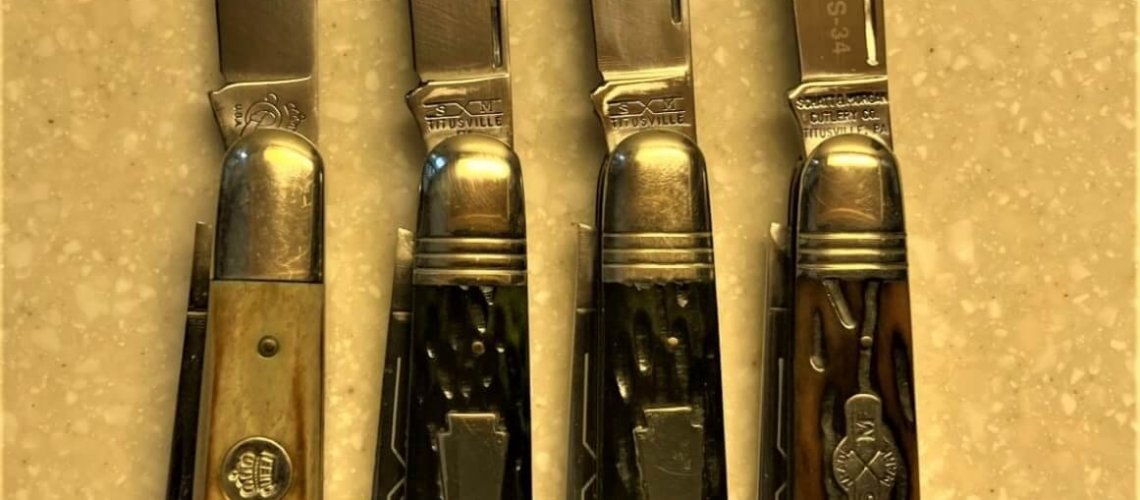
Dan Lago
9-18-2023
We gratefully acknowledge the contributions of Fred and Linda Fisher in expertise and sharing photographs used in Jim Sargent (2008). We also recognize and appreciate the work of David Clark for his work on Schatt & Morgan Catalogs and historical use of “fancy bolsters.” Please see our references.
Introduction.
This article continues our series of popular pocket knife patterns frequently produced by Queen Cutlery and their forerunners. We begin with Schatt & Morgan, move through Queen City and Queen Cutlery Farmer jacks, and provide a detailed list and photographs of many cataloged AND non- cataloged English Jacks in the new Schatt and Morgan re-introductions since 1991 and Daniels Family era of Queen in their last years. We summarize at least 37 different English Jacks made by Schatt & Morgan and Queen, with acknowledgement that more might show up.
We refer to an “English jack” as 4.5″ long closed, with a straight handle, being a bit narrow at the top end and slightly larger at the cap end. The knife may have one or two blades both opening from the narrower top end. Either a clip blade or spear blade may be the primary and usually a large pen blade is the secondary blade. While the origins of this pattern are very old (jackknife — Wordorigins.org) it is probable that the style of the knife emerged in the 1600s, in northern England, and was commonly used in the English colonies before the American revolution. It is a large, heavy use knife, as we can tell by Queen cutlery, after 1945, calling the knife a “Farmer’s jack.” There are smaller versions of an English Jack pattern, but we will focus only on the larger version in this paper.
Shatt & Morgan English Jacks. Twelve Different English jacks were shown in Schatt & Morgan catalog in 1907, with two different styles of bolster – rounded or “fancy bolster,” (David Clark, Personal communication, 2023; or generically “coined bolsters”, R. Welch, 2023) and with both ebony and ”imitation stag bone” handles (shown on pp. 28, 88, and 89, in the 1907 catalog, Clark, 2010). All are named as “English Jacks” in his summary of patterns on SM-Pattern-Numbers-Pat-number-sort-1.0-1.pdf (queencutleryguide.com).
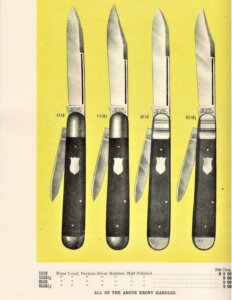
Figure 1. Page 88, 1907 Schatt & Morgan Catalog (David Clark, 2010). Page 89 shows the exact same knives covered in “imitation stag bone” also with rounded or “fancy” top bolster, suggesting several levels of choice for customers wanting either a working or dress knife. No sales data for these versions. All these knives are very hard to find today.
All these knives look exactly like the modern English Jacks Queen Cutlery sold right up to 2017, when they closed their doors. This is a nice example of Queen going back to look at a popular knife and appreciating its features.
Queen City Cutlery. Queen City never produced a catalog that has been found by collectors, so they are hard to characterize beyond knives found in collections. However, many folks have samples of Queen City English jacks, although we do not know what they called them or what model # they used. It is very likely, though we only show a spear blade, they also produced this knife with a clip blade (see Figure 2).
Queen Cutlery, 1951
Queen retooled after World War II military contracts, and gradually brought out more pocketknives. The spear blade “Large farmer’s knife spear point” (Model # 29) was first offered in 1950, and the “Large farmer’s knife, Clip Pattern” (Model #28) in 1951. Both knives were in the catalog though 1977, when Queen began to tool up for collectors’ interest in new knives. Figure 3 is from the 1952, catalog, p., 27, showing both knives in the same catalog.
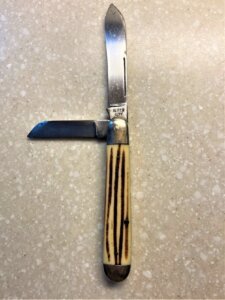
Figure 2. A Queen City English Jack with spear primary blade, sheepsfoot secondary blade, and with Winterbottom bone handles. These blades show considerable polishing to remove some rust on the blade, since this knife is well over 70 years old. Both blades have half stops, have been sharpened many times, and are still very sharp. This great old knife still has a very strong snap on opening and closing for both blades.
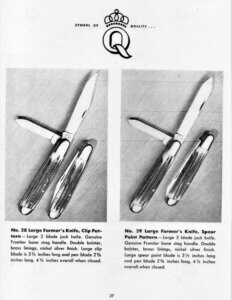
Figure 3. Page 27, 1952 Catalog. Both knives were initially offered in Carbon steel, but were included Queen’s gradual shift to stainless steel (“Queen steel” and “Qsteel”) in the middle 1950s. These knives had half stops.
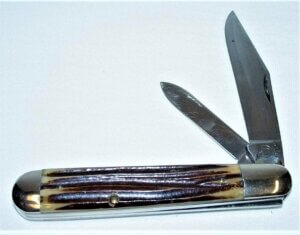
Figure 4. A Farmer ‘s Jack with Clip blade (#28) showing a “Big Q” tang stamp and Winterbottom bone covers. (Fred and Linda Fisher photo).
Figures 4, 5, and 6, show some examples of the early production of Queen Cutlery in this traditional pattern. It is easy to see that in all regards the Farmer’s knife is the same as the “English Jack” of both early and later re-introductions of Schatt & Morgan knives, which did NOT use the “fancy” bolster most of the time. Queen favored knives as “tools,” not made for collectors with little visual decorations. These knives are quickly snapped up when they show up in collector marketplaces, especially if they are in good shape. Many of these knives have been used hard and sharpened poorly, but if in good shape, they are a prize.
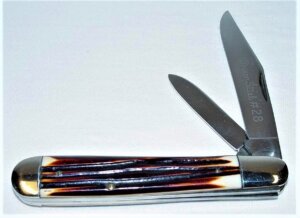
Figure 5. Another Farmers Jack (#28) in “Burnt Orange” Delrin, an early effort produced only in 1959. In the later years, after the emergence as “English Jacks” in the Annual Schat & Morgan Keystone series, the number #29 has taken over in the public mind, so we are showing a few more of the clip point version of the knife. (Fred and Linda Fisher photo).
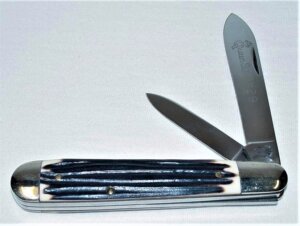
Figure 6. Another Farmer Jack with Spear Blade (#29) showing the 1972 anniversary tang stamp, with a darker Delrin Winterbottom cover. (Fred and Linda Fisher photo)
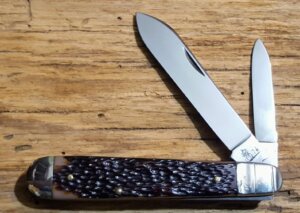
Figure 7. An unusual English Jack that might be made from Queen parts. This knife shows a 1976 tang stamp along with a fancy top bolster not used during that period, and with a “chipped bark” style of Delrin plastic used throughout the 1980s, but without the usual shield. The Farmers knife nor “English Jack” was never cataloged in this series. Queen might have made this knife as a trial, or as a special project, but it is also known that Queen sold a lot of parts at this time (see Fisher & Lago, 2020 – two separate articles) but the odd collection of parts raises issues for this knife. This knife might be a good “user” with 440 stainless steel and durable handle material. Sad to say, “parts knives” are a definite concern to Queen collectors.(Internet photo.)
After the dropping the farmer’s knife with both blade styles in 1977, the English Jack knife did not show up in the catalog again in either the Rawhide series or the Chipped bark series until the Burnt bone series, but we have a hint that the pattern was still favorite of some in the company when it was included in the “Genuine Stag” Series begun in 1981. Figure 8, shows a nice example of this big jack knife. added in the 1983 advertising sales flier (New for 1983) for the knife. Note it was still called a “Farmers Jack.”
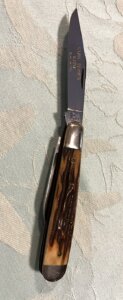
Figure 8. The “Farmers knife” in a two-blade version with primary clip blade as part of the “Genuine Stag” series, shown in the sales flier, “New for 1983”, (page 1, lower corner). (Fred and Linda Fisher photo).
This series was Queen first cataloged set of stag knives, often found with massive stag covers and very deep blade etches. Collectors have never had luck finding catalogs or prices lists for the middle period of the 1980’s. It may be that this Farmers Jack was never publicized in any sales material beyond the one flier. Since this knife was made for only one year, 40 years ago, it is not easy to find compared to the other, earlier “genuine stag series” patterns and commands a high price when found.
The burnt bone (model # BB8) was introduced in 1993, as shown in Figure 9. It was a two-blade knife and its covers were somewhat thick and have a larger flat surface, befitting use as a “farmers” knife, rather than a more finished, gentler rounded profile of the Keystone knives beside it. The knife carried an inscribed Queen crown circle shield. Knives in this series still sell well and this large jack was made for only two years, so it is a little difficult to find.
The name “English Jack” did not appear in the Schatt & Morgan Keystone series until 1996. As we will see in the last years of the company, the basic design of the two Keystone knives in the center of Figure 9, provided a template (and parts) for many small editions of the pattern in its final years as shown in Figures 12, 13, 17 – 20.
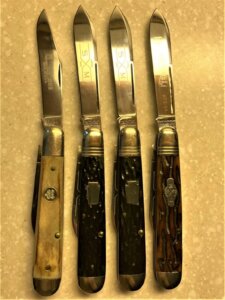
Figure 9. Four English Jacks produced in the 1990’s by Queen. On the left is a burnt bone (#BB8) from 1993-5 with incised Queen crown shield (sold as a “Farmer”), second, is a “Green Emerald bone” from 1996; third, a “Deep Blue jigged bone” from 1997; and fourth, a brown worm grooved File & Wire, in 2000. Both the “keystones” in the middle are very dark and do not show the color often associated with those versions, but both feature the threaded top bolsters now frequently seen in Queens with this pattern.
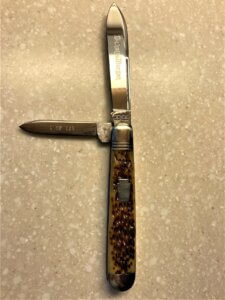
Figure 10. An English Jack with “Golden Age Bone” using a blade marked 1995. Probably an overrun or “practice” production in a small edition of 125. There might well be other versions of this knife also made with different covers. This is a very tight and well-made knife. Notice the larger size Keystone shields in these 1990’s knives, compared to later versions.
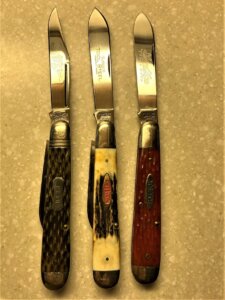
Figure 11. Three English Jacks made in late 1990s and early 200os. Left is a green jigged bone serialized “Queen Classic” series SFO by Ken Daniels with Script Queen City tang stamp an unusual “QCCC” shield; center is a Stag Robeson pocketeze, usually in an edition of 100; and right is a single blade Robeson ShurEdge brand in strawberry jigged bone, usually in an edition of 200.
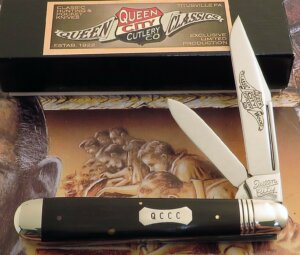
Figure 12. A similar version to the Queen City English jack in Figure 10, also serialized, in ebony, with the same QCCC shield – there might be others in this series, since the edition sizes in these knives were very limited. This image shows a nice example of the blade etch and the appropriate box. (Internet photo).
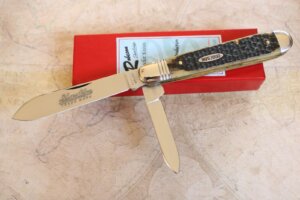
Figure 13. A Robeson English Jack in ShurEdge brand with a “snakeskin” bone cover. Usually in an edition of 200. (Internet photo).
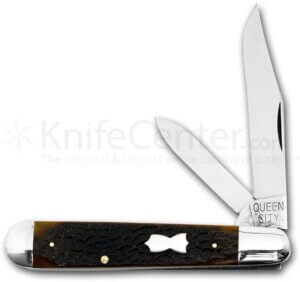
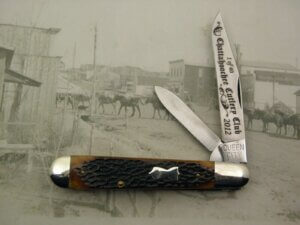
Figure 14. English Jack with block Queen City tang, in 2012, with Catalina Brown jigged bone and bowtie shield. The bottom photo shows the same knife offered to Chattahoochee Collector Club members with blade etch and date. (Internet photos)
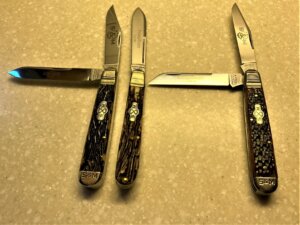
Figure 15. Three English Jacks with fancy bolsters with File & Wire shields made during the Daniels Family era by Queen about 2014 – 2015. These knives are varied in the number and type of blades, the blade steel, and have different, but high-quality, bone or stag covers. Two show signature cap end bolsters while the signal blade is barehead. The knives with large secondary blades are very unusual in Queen’s treatment of English Jacks and the only time the fancy bolsters were used in the modern period – the only times we know of when that was done. They are all in small editions.
Other Queen English Jack knives from Public Internet photos.
The following knives are offered as examples but have not been examined in detail. They might help expand the availability of Queen knives of this pattern for you to seek out.
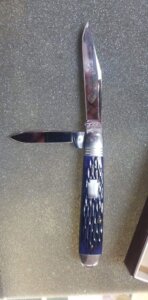
Figure 16. An English Jack 1997 Deep Blue Bone, an SFO annual knife ordered by the Southern California Blades Club. Compared to the similar knife in Figure 8, you can notice the wide variation in the color of the bone handle. (Internet photo).
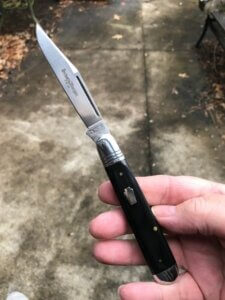
Figure 17. An English Jack in a Shatt & Morgan Keystone model, though with a smaller Keystone shield than the earlier knives. These knives were made in black handles; Black Micarta, Buffalo horn, and Ebony wood, and some also had Mother of Pearl shields instead of Nickel Silver, or no shield. Some were also made with the traditional second smaller blade, while this one shows a single blade. They were often made in editions of 25 or 30 during Queen’s last years, 2016-2017. These were very popular knives and sold quickly , so it is very difficult to tell how many different versions were created. (Internet Photo). So, we cannot provide a total listing for this set of knives. Some, like Micarta with pearl shields are very well finished and beautiful, but some are not polished or finished for function as much as we have come to expect. As prices rise, we recommend studying some of these later knives a bit more to see if it meets your standards before completing a deal.
This knife and the others in this section show that the earlier model # 28 with a clip blade, has been replaced by the #29 designation. These later knives are all listed “Model #29s,” English Jacks, even though they frequently show clip blades.
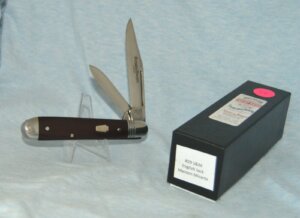
Figure 18. A two bladed Schatt & Morgan English Jack in a box and with a label that identifies the handle as Maroon micarta. The edition size is not shown, but it would also be approximately 25 -30 knives. (Internet photo).
If the blade steel matters to you, you would want information from the pile side of the knife you are considering. Carbon steel was used in many later knives to save costs, but we have also seen stainless knives and in some cases D2 or even ATS34 blades used as all inventory resources were turned into knives. Queen, under Daniels Family, was very good in specifying the steel used on every tang. As these knives get harder to find, you might need to “accept what you find, or keep looking much longer.”
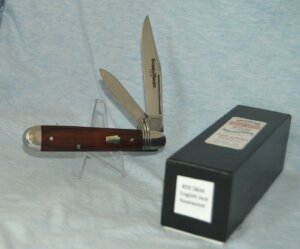
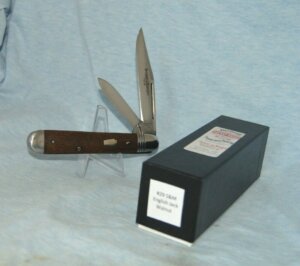
Figure 19. Two more two-bladed English Jacks with clip blades, upper with Rosewood covers; and bottom with Walnut covers. (Internet photos).
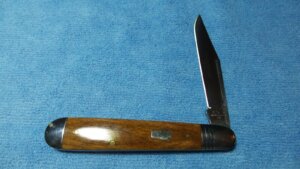
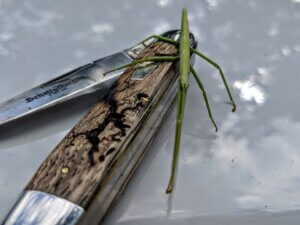
Figure 20. Top, A Single blade English Jack with small Keystone, of unknown wood – might be stabilized “Marvel Wood”; Bottom, a two blade English Jack in “lightning Wood” in an edition of 30. (Internet Photo, with praying mantis!).
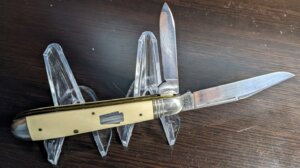
Figure 21. A Final English Jack in light colored bone or acrylic that shows an extra pin up near the Keystone shield. Compare this knife with most of above samples showing that Queen sometimes used the extra pin, and sometimes, not. It also uses earlier large Keystone shield and the pen blade shows some use. These features suggest this knife might have been repaired/customized with new covers.
So, as you look for unusual Queen English Jacks, you will be faced with changes that might have been made after Queen closed its doors. As far as we are concerned, that is up to each Queen Collector. It is your choice to purchase and enjoy any knife you like at what you feel is a fair price. We have shown a large number of English (or Farmer) Jacks that provide a source for seeking other examples of this pattern to enjoy in building your collection.
NOTE: This is a first edition, and we appreciate suggestions for improvement and additional examples of Queen, Queen City, or Schatt & Morgan, English Jacks from your collection that can add to this summary. We also thank Internet users who posted their knife images on public sites so that we may add them so collectors can learn more about their hobby.
References
Anonymous. (N.D.) “jackknife” — Wordorigins.org.
Clark, David (2010). Reproduction of Schatt & Morgan 1903 and 1907 Catalogs. (1903, 52 pp, 1907, 128 pp). Published by Lois and Clark Publications, 349 Windsor Dr., Marietta GA 30064. Available from: http://www.knifeworld.com/schatt-morgan-catalogs1.html or https://www.allaboutpocketknives.com/catalog/9580-early-schatt-and-morgan-catalog-reproductions.
SM-Pattern-Numbers-Pat-number-sort-1.0-1.pdf (queencutleryguide.com). Prepared by David Clark.
Clark, David (2023). Personal communication about both Remington and Camillus using the term “fancy Bolsters” in their marketing of similar bolster in their knives.
Fisher, Fred and Dan Lago (2020) See two articles:
Parts-Knives-1972-1981-3-2020.pdf (secureserver.net) Parts-Knives-after-the-Queen-Bankruptcy-3-2020.pdf (secureserver.net)
Model-29-10-2019.pdf (queencutleryguide.com)
Jim Sargent (2008). American Premium Guide to Knives and Razors: Identification and Value Guide. Pp. 421-503. Krause Publications, 700 East State Street Iola, Wi 54990. www.krausebooks.com.
Welch, Robert, (2023) Personal communication on “Coining” bolsters. As described in Coining (metalworking) – Wikipedia.
